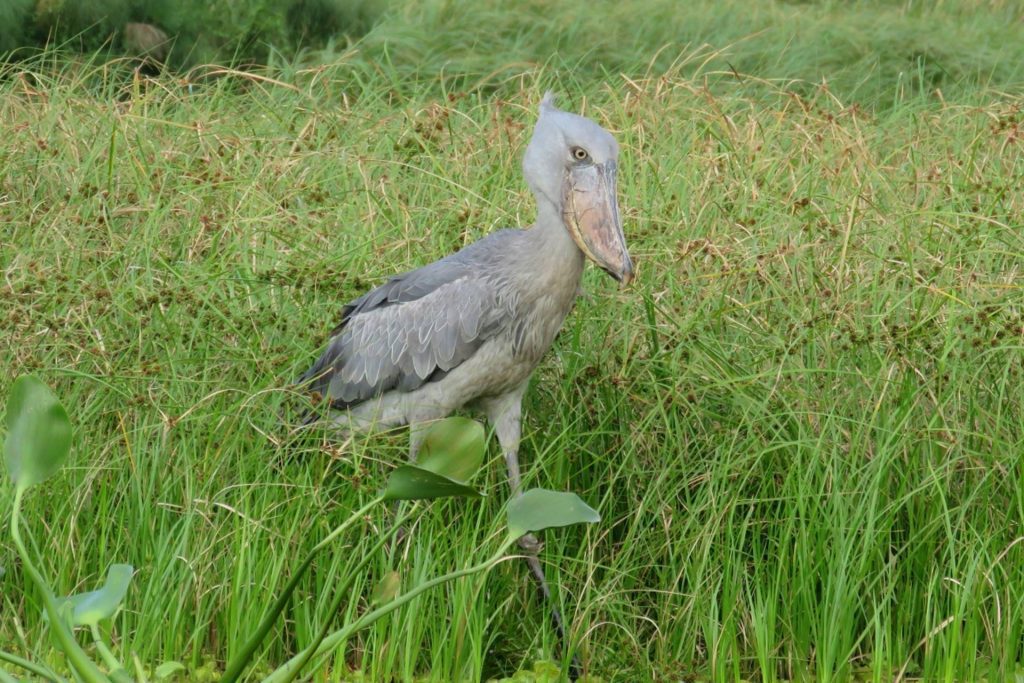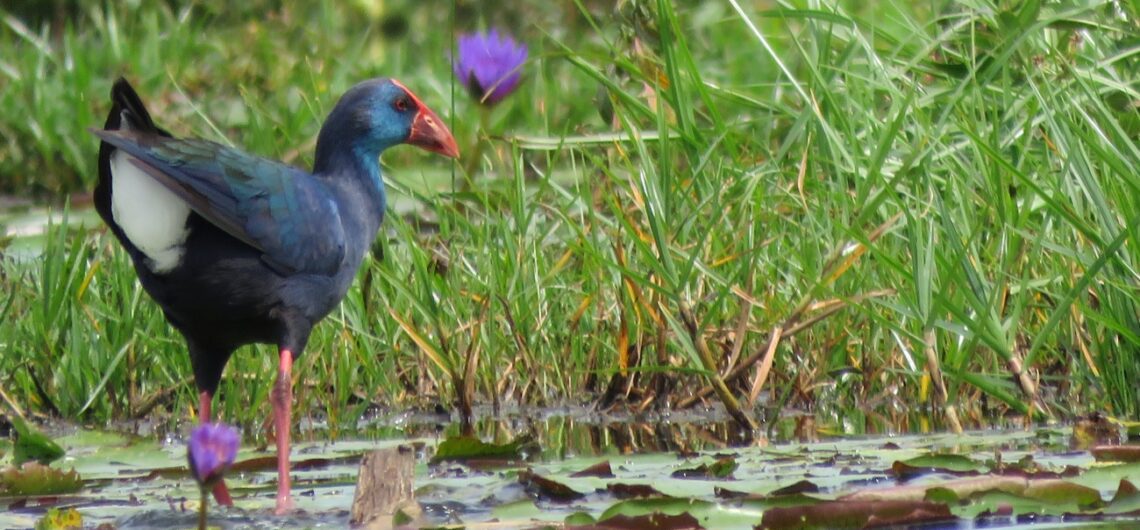Mabamba Swamp and Wetland is a special place in Uganda where you can see many amazing birds. Uganda is known for having great spots for bird watching, and Mabamba Bay Swamp is one of them. It is easy to get to because it is near Kampala city and Entebbe town. You can see many of Uganda’s famous birds there without having to travel far to remote parks.
Mabamba Wetland is a big swamp near Lake Victoria in Uganda. It is not far from Entebbe town (about 40km) and Kampala city, in a small village called Kasanje. People who live near the wetland mostly do activities like hunting, fishing, and mining to make a living. However, what really makes Mabamba Swamp famous is its incredible variety of birds. There are more than 260 different types of birds there. It is a popular place for tourists visiting Entebbe town. Some of the birds you can see include the Papyrus Yellow Warbler, Shoebill Stork, Blue Swallow, and Sitatunga.
Because of its fame internationally, Mabamba Swamp has become an Important Bird Area, attracting many bird watchers to Uganda. It is one of the best places for bird watching safaris in Uganda. Being close to Entebbe International Airport makes it a perfect starting point for people interested in long safaris in Uganda. The main attraction here is the Shoebill Stork. Along with Murchison Falls National Park, Mabamba Swamp is the top spot to see Shoebill Storks. You can see them all day in Mabamba and Murchison Falls National Park.
However, Mabamba Wetland is not just about Shoebill Storks; it is also a sanctuary for four endangered species: the Papyrus Gonolek, Blue Swallow, Pallid Harrier, and White-Winged Warbler. There are many other bird species in the swamp too, such as the Yellow-throated Greenbul, Yellow-rumped Tinkerbird, and Yellow-billed Duck, among many others.
Mabamba Swamp and Wetland with Shoebill Stork and Birding Tours in Mabamba Swamp
The Shoebill Stork, called “Bbulwe” locally, is named after its big bill that looks like a shoe. It is the most popular bird in Uganda, attracting a lot of attention. This bird is shy and interesting, with a mysterious look. Its standout feature is its huge, uneven, and yellow bill. Some people might consider Shoebill Storks unattractive, but tourists and experienced bird watchers find them fascinating. Many bird watchers come to Uganda just to see these big birds.
Shoebill Storks are found in the papyrus swamps of Sub-Saharan Africa, including countries like DR Congo, Zambia, Tanzania, Uganda, and Sudan. Uganda alone has around 1000 of these birds. In Uganda, you can spot Shoebill Storks in various places like Queen Elizabeth National Park (specifically the Ishasha Sector), Nabajuzi Swamp in Masaka, Murchison Falls Park, Ziwa Rhino Sanctuary, Lake Mburo National Park, Semliki Wildlife Reserve, and around Lake Kyoga. These storks mostly eat Lungfish, but they also feed on smaller water birds, water snakes, frogs, lizards, turtles, snails, and rodents. In Mabamba, their favorite food is Lungfish, which are abundant because many Buganda people do not eat them. Interestingly, one of the Buganda clans is even named after the lungfish.

How to Access Mabamba Swamp and Wetland
From Entebbe: People traveling from Entebbe can take the old Entebbe-Kampala road and turn off at Kisubi. From Kisubi, they can continue driving to Nakawuka, then Kasanje, and finally arrive at Mabamba.
From Kampala: If you are coming from Kampala, start by taking a taxi from the new taxi park to Kasanje trading center. Once you reach Kasanje trading center, you can then rent a motorcycle to get to Mabamba, which is around 13.5 kilometers away.
Alternatively, instead of going by road as previously explained, a simpler and more convenient way to get to the swamp from Entebbe town is by taking a speedboat across Lake Victoria. This route is more exciting and lets you enjoy the stunning Lake Victoria scenery while avoiding Entebbe town and the airport. It usually takes about 45 to 50 minutes by speedboat to reach the starting point in Mabamba. You can rent speedboats from certain hotels in Entebbe town or at the Entebbe sailing club.
When you get to the starting point, you will see lots of organized birdwatching guides and boatmen ready to take you into the wetland to see the birds. They have a leader who speaks for them. Each canoe can only take three birdwatchers, not counting the guide and boat driver. First, you will need to pay a community fee of around $7 at their small office. It costs about $35 for the boat and guide together. These boat owners and birding guides are locals from nearby communities. When you pay for their services, you are helping the community and protecting the birds and other animals in the wetland.
Once the boat starts moving through the reeds, keep an eye out on both sides and in the air. Your guide and boatman will help you get close to the birds by steering through the papyrus. Make sure your binoculars and camera are ready. The number of birds here might surprise you if you are not ready. Look for bee-eaters, kingfishers, and other types of birds. Do not forget to admire the beautiful butterflies and lotus flowers.
The best time to spot Shoebills is in the morning when they are out hunting. Taking photos of Storks is easier than many other bird species because they stay still for a long time while they watch for fish, frogs, and other prey before they attack.
More information about Birding tours in Mabamba
Birdwatching tours happen every day and last about 4 hours. If you want a full day of birdwatching, you can ask for it. The best time for birdwatching is between September and March when many birds migrate from Europe. It is important to book a tour of Mabamba swamp a day before so they can plan well. Your tour company or private driver should pick you up very early in the morning from your hotel or home. For the best birdwatching experience, bring a backpack with packed food in case you get hungry, binoculars, insect repellent, a hat, sunscreen, a rain jacket, and long-sleeved shirts.
Other things to do and look out for while visiting the Mabamba swamp
Canoeing: You can arrange for longer canoe trips to see more birds, go fishing, and explore the nearby islands of Lake Victoria. It is important to wear life jackets when getting on the canoe. If you do not have one, pick a boat that can give you one.
Spot fishing: Before tourism became more common, the main thing people did in Mabamba was fishing. Fishing is still the main way people make money in the area. The most common fish species people catch are Tilapia, mudfish, lungfish, and the big Nile Perch. There are many fishermen in the area. You can either join one of them or watch them from a distance. If you want to join them, you can bring your own fishing gear or use one of the hooks and rods made by locals.
Village walks and visiting Craft Shops: Village walks let you spend time with the locals and learn about their lives and how they manage. Many of the people living near the swamp do subsistence farming. You can also visit some craft shops to see lovely bags, mats, baskets, and huts that are skillfully made. Many of these things are crafted using reeds from the swamp. The swamp also gives herbs and materials for building local huts.
Watching Butterflies: While birdwatching is the main attraction of a tour in the Mabamba wetland, the many different types of butterflies are also very impressive. There are over 200 species of butterflies in the Mabamba swamp. The most commonly seen ones are the Bicyclus sebetus, Acraea consanquine, Acraea aganice, Achaea aurivilli, and Abisaraneavei.
Spotting the Sitatunga antelope: The Mabamba swamp is a significant home for the Sitatunga antelope. When you are on a birdwatching tour in the huge swamp, you might come across these shy animals. Unfortunately, their numbers have gone down lately because of poaching that is not controlled. Poachers find and catch them by burning the places where they hide—the marshes. The government and other wildlife protectors are trying to keep them safe by educating the communities about the importance of protecting them.


Comments